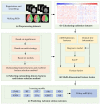Novel Survival Features Generated by Clinical Text Information and Radiomics Features May Improve the Prediction of Ischemic Stroke Outcome
- PMID: 35885568
- PMCID: PMC9324145
- DOI: 10.3390/diagnostics12071664
Novel Survival Features Generated by Clinical Text Information and Radiomics Features May Improve the Prediction of Ischemic Stroke Outcome
Abstract
Background: Accurate outcome prediction is of great clinical significance in customizing personalized treatment plans, reducing the situation of poor recovery, and objectively and accurately evaluating the treatment effect. This study intended to evaluate the performance of clinical text information (CTI), radiomics features, and survival features (SurvF) for predicting functional outcomes of patients with ischemic stroke.
Methods: SurvF was constructed based on CTI and mRS radiomics features (mRSRF) to improve the prediction of the functional outcome in 3 months (90-day mRS). Ten machine learning models predicted functional outcomes in three situations (2-category, 4-category, and 7-category) using seven feature groups constructed by CTI, mRSRF, and SurvF.
Results: For 2-category, ALL (CTI + mRSRF+ SurvF) performed best, with an mAUC of 0.884, mAcc of 0.864, mPre of 0.877, mF1 of 0.86, and mRecall of 0.864. For 4-category, ALL also achieved the best mAuc of 0.787, while CTI + SurvF achieved the best score with mAcc = 0.611, mPre = 0.622, mF1 = 0.595, and mRe-call = 0.611. For 7-category, CTI + SurvF performed best, with an mAuc of 0.788, mPre of 0.519, mAcc of 0.529, mF1 of 0.495, and mRecall of 0.47.
Conclusions: The above results indicate that mRSRF + CTI can accurately predict functional outcomes in ischemic stroke patients with proper machine learning models. Moreover, combining SurvF will improve the prediction effect compared with the original features. However, limited by the small sample size, further validation on larger and more varied datasets is necessary.
Keywords: clinical text information; ischemic stroke outcome; machine learning; radiomics features; survival features.
Conflict of interest statement
The authors declare no conflict of interest.
Figures









References
-
- Puzio M., Moreton N., O’Connor J.J. Neuroprotective Strategies for Acute Ischemic Stroke: Targeting Oxidative Stress and Prolyl Hydroxylase Domain Inhibition in Synaptic Signalling. Brain Disord. 2022;5:100030. doi: 10.1016/j.dscb.2022.100030. - DOI
-
- Murphy B.D., Fox A.J., Lee D.H., Sahlas D.J., Black S.E., Hogan M.J., Coutts S.B., Demchuk A.M., Goyal M., Aviv R.I., et al. Identification of penumbra and infarct in acute ischemic stroke using computed tomography perfusion–derived blood flow and blood volume measurements. Stroke. 2006;37:1771–1777. doi: 10.1161/01.STR.0000227243.96808.53. - DOI - PubMed
-
- Pinto A., Amorim J., Hakim A., Alves V., Reyes M., Silva C.A. Prediction of Stroke lesion at 90-day follow-up by fusing raw DSC-MRI with parametric maps using Deep Learning. IEEE Access. 2021;9:26260–26270. doi: 10.1109/ACCESS.2021.3058297. - DOI
-
- Kwakkel G., Kollen B., Lindeman E. Understanding the pattern of functional recovery after stroke: Facts and theories. Restor. Neurol. Neurosci. 2004;22:281–299. - PubMed
Grants and funding
- 62071311/National Natural Science Foundation of China
- SZWD2021010/The Stable Support Plan for Colleges and Universities in Shenzhen of China
- JL201919/The Scientific Research Fund of Liaoning Province of China
- 2021ZDZX2008/The special program for key fields of colleges and universities in Guangdong Province (biomedicine and health) of China
LinkOut - more resources
Full Text Sources
Other Literature Sources
Miscellaneous

